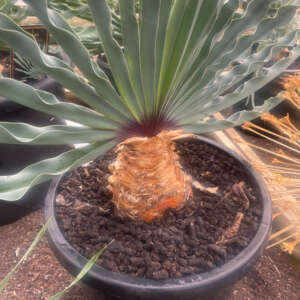Boophone Disticha Growing Guide
Boophone Disticha
Boophone Disticha is known by many common names, including the century plant, gifbol, or poison bulb. This plant is a truly rare and unique addition to any plant collection. It is admired for its breathtaking distichous foliage, with each wavy-edged leaf stacked on top of each other, either side of an above-ground bulb.
They lose these leaves when in bloom as they develop bright pink and red flowers with curled back petals. Flowering can be unpredictable and short-lived but the ornamental nature of Boophone Disticha leaves makes achieving bloom a secondary concern. Their unique appearance and fascinating growth cycle intrigue many plant enthusiasts.

Boophone Disticha – Garden Express Australia
What Are Boophone Distichas?
The Boophone Disticha is from the Amaryllis family and is native to all provinces of South Africa. They have a rich history of uses, both in traditional African medicine and more infamously for being used to make poisoned arrow tips.
It is best to keep this plant away from curious pets, but it is harmless as long as it is not ingested. Despite its unique background, this plant is safe to grow indoors and is an eye-catching option for both beginner and experienced plant owners, given the right care.
Benefits of Growing Boophone Disticha
Boophone Disticha are the stars of many nurseries for their unique, architectural leaves that add vibrancy and excitement to any space they occupy. Their distinctive appearance inspires intrigue, and owners should expect a few questions from curious guests who visit.
These plants also require very little maintenance once established due to their proficiency for growing in dry, harsh climates. It can be difficult to find Boophone Distichas for sale but their beauty is well-worth the hunt. Fortunately, Garden Express stocks these magnificent plants.

Boophone Disticha 300mm – Garden Express Australia
How to Grow Boophone Disticha
Plant Size
Boophone Disticha can grow to around 40 cm in height when fully matured. Their leaves will spread out like a fan to cover a width of about half a metre. As they grow, they develop long, deep root systems that require an appropriately deep pot.
Best Soil for Boophone Disticha
Boophone Disticha is sensitive to excess moisture during the growing season and needs to remain completely dry during dormant periods, thus making it best grown in pots.
The typical potting mix should contain a custom blend with 25% pumice, perlite or a similar coarse material to aid drainage. Also add a layer of compost to provide the nutrients it needs to thrive.
How to Plant Boophone Disticha Bulbs
Plant the bulbs so that the neck and at least two thirds of the bulb are above ground level. Bulb roots should remain intact and be handled with care. These root systems will grow best in a 15–20 cm deep pot as a juvenile and should be replaced with a bigger pot as it matures.
When to Repot
Roots will grow deep into the soil to help the plant reach its maximum potential. It is best to repot every couple of years to keep up with its growth.
When repotting, try to keep at least half of the bulb above ground and do so during dormant summer periods to decrease the disruption to your plant. When the bulb nears maturity, it will require a 40–50 cm deep pot.
It is best to avoid repotting when fully grown, as this can disrupt the flowering period. Due to its poisonous nature, always wash your hands well after repotting.

Home Page – Garden Express Australia
Boophone Disticha Plant Care
Yearly Cycle
The seasons of the year are tied closely to the growth cycle of this plant and should be kept in mind to help your plant grow. Boophone Disticha has a winter growing period where they develop vibrant, blueish-green leaves from their scaly bulb.
In spring, they bloom a hemispherical arrangement of delicate pink or red flowers. These fragrant flowers can be erratic when they decide to bloom, but it is always a welcome and proud moment when they do.
During summer, your plant will lose its leaves or flowers and enter a dormant period. During this season, your plant will require very little maintenance. By late autumn, you’ll be able to coax it out of its hibernation with a well-deserved watering session.
Water Only As Needed
During its winter growing period, Boophone Disticha is sensitive to moisture and should only be watered when the soil is completely dry. Lower the amount of water given as the leaves start to yellow in late spring.
By its dormant period in summer, the plant should be left completely dry to prevent bulb rot. Watering can then begin again in late autumn to encourage new growth to begin. New leaves will appear again as the cycle continues.
Keep in a Sunny Position
To begin with, place your plant in a bright, filtered light to avoid burning. It is important to move it each week to increase its sun exposure a bit at a time.
During growing periods, leave your plant in a sunny position where it can get full sun for as much of the day as possible, such as an outdoor patio. In hot Australian climates, some afternoon shade might be needed during the dormant season.
Where to Find Boophone Distichas
While these plants are highly sought after and regarded, it can be difficult to find high-quality Boophone Disticha seeds and bulbs. Their uniqueness and fascinating life cycle make them the perfect addition to any plant collection. Take advantage of Garden Express’s special release of Boophone Disticha to begin growing your own today.






